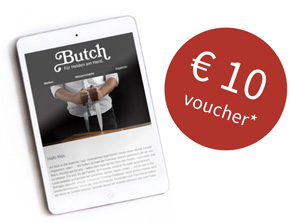
Nordklinge Knives
A piece of steel and a wooden handle. Together they make a knife, very simply put. At Nordklinge, this is the essence, the essential aspect of what a chef's knife is all about. Nordklinge knives are hand-forged in Finland from carbon steel and refined by a German master. This unusual combination of Finnish blacksmithing and German quality craftsmanship results in a successful synthesis: high-quality chef's knives with exceptional sharpness and breathtaking vintage aesthetics in robust construction. Genuine, honest, reliable.
At first glance, a Nordklinge knife inevitably brings to mind tools from the Stone Age – and that's intentional. Archaic knife shapes, rough-looking blades, simply shaped wooden handles. Nordklinge aims to set a counterpoint with its knives, to stand out from overly perfect knife collections, crafted to the hundredth of a millimeter, where one knife is exactly like the other. For Henrik Terschüren, the man behind the brand Nordklinge, such knives are anonymous utility objects. He loves cutting tools with personality, with which a relationship develops, and with which working is a true pleasure. Nordklinge knives transport us to times long past, they awaken the longing for the genuine, the unadulterated, and if you own a "Vankka," you are indeed a little proud of this extraordinary piece. "Vankka" is Finnish, by the way, and means "solid." This is also one of the best product descriptions for this knife brand. Nordklinge does not claim to produce the very best knives in the world. However, if you value an unusual appearance that aligns with inner values, if you find handcrafted items beautiful and desirable and are willing to accept a higher maintenance effort, then Nordklinge knives are a good choice.
The Production of Nordklinge Knives
Nordklinge knives are handcrafted in Finland by an award-winning blacksmith (his emblem is exclusively found on the blade). The refinement of the knives with "extra sharpening" is carried out in Germany by the Kubesch grinding shop in Fulda, a master craftsman business with a long-standing tradition. For the Nordklinge brand, the unusual combination of Finnish blacksmithing and German quality work is a successful synthesis that the company is proud of. Henrik Terschüren also values fair dealings with manufacturing partners, as he believes the name Nordklinge should stand not only for exceptional knives but also for sustainable top craftsmanship from the EU.
The Suitability of Nordklinge Knives
The blade silhouette of the "Vankkas" is based on traditional forms and is inspired by both European and Asian designs. This results in true all-rounders. All-purpose chef's knives suitable for a wide range of cutting tasks in the kitchen. The wide blade allows for safe and comfortable cutting, whether raw or cooked meat or delicate fish. Vegetables can be effortlessly chopped, and the pointed shape of the knife blades is useful for opening and coring, for example, peppers. However, at least the knives in the "extra sharpening" category do not take kindly to one thing: Even though Nordklinge knives resemble cleavers, they are by no means intended for chopping - for example, bones - and the blade would suffer irreparable damage. Frozen foods and woody herb stems are also taboo for a Vankka with extra sharpening.
Nordklinge - The Material
The Blade
The knife blades are made from Uddeholm STR carbon steel, one of the finest European blade steels. It is a fine steel with high hardness (= HRC 58) and excellent cutting properties, similar to Japanese blue paper steel, whose quality is highly appreciated not only in Japan but worldwide. The dark color on the upper part of the blade is a natural coloration: the so-called forge skin - also known as rolling skin - which forms during the blade shaping process through pressure and heat.
The advantages of the steel used: Carbon steel knives achieve extreme sharpness and have a long edge retention, meaning the blade stays sharp for a long time. However, carbon steel is prone to rust and tarnishing with stain formation, as carbon steel oxidizes under the influence of water and acids - unlike stainless steels. Proper and consistent care prevents this. Important: Do not leave knives wet or damp after use! Rinse under running water after cutting and DRY. Also, occasionally in between. We also recommend treating the knives with camellia oil. Nordklinge offers the Sinensis Camellia Oil from Dictum - also available here in the Butch Shop.
You think all this sounds a bit tedious? In our opinion, knife care has a spiritual aspect and becomes a habit with a little practice. As a reward, you will enjoy your Nordklinge knife for a long time.
As was common with us in the past, carbon steels are still used in Japan for knife production and are very popular. The care requirements are well known - this is part of an old tradition and is not seen as a disadvantage. Even today, China, Japan, and Vietnam remain true to traditional manufacturing and gladly use knives made of carbon steel.
The Handle
The ergonomically shaped handle of each "Vankkas" is made of solid Karelian curly birch. This wood grows only in eastern Finland and the adjacent Russia and has been a highly valued material for knife and tool handles since ancient times. Botanically, curly birch refers to a special, abnormal growth of a birch, which is rare. The trunk adds only a few millimeters in circumference each year. Therefore, this type of wood is characterized by high hardness and long durability. Additionally, this type of birch has a beautiful grain and fits exceptionally well with the original effect of the blades.
Nordklinge - The Knives
Nordklinge Vankka Pieni
The "Vankka Pieni" is an all-rounder. A true multi-purpose knife, excellent for cutting meat, fish, and vegetables. "Pieni" is Finnish and means "small."
Nordklinge Vankka Suuri
The "Vankka Suuri" is particularly well-suited for cleaning and chopping herbs and cutting vegetables. With a "Suuri," very fine cuts are possible with vegetables. It is practical that the cut food can be picked up with the wide blade and placed directly into the pan. And you've probably already guessed: Finnish "Suuri" means "large."
Nordklinge Vankka Tasku
The "Vankka Tasku" from Nordklinge is a small all-purpose knife. Whether at home in the kitchen or on the go - protected in the matching leather sheath - as a snack, mushroom, or outdoor knife: The Tasku is a practical and attractive companion. "Tasku" means "pocket" in Finland, derived from its use as a pocket knife.
Nordklinge - The Variants
The Vankka Pieni and Vankka Suuri (*) are available in the following variants:
- Original grind & forge skin
- Extra grind & forge skin
- Extra grind & sandblasted
- Extra grind & satin-finished
* The Vankka Tasku is only available in the "Original grind & forge skin" version.
Original Grind
In the "Original grind" version, the Nordklinge knife comes directly from Finland. The blade is slightly "convex" ground - making this edge more robust than the extra sharpened knives. A so-called convex blade shape can be found, for example, in axes. The cross-section of a blade with a convex grind resembles a U, while a flat grind represents a V. With the original grind knives - but only with these! - thin bones, fish bones, and slightly woody herbs can be cut without risk to the blade.
Forge Skin
The black surface on the blade is called forge skin, or rolling skin. It naturally forms during the rolling process. This layer consists of various iron oxides and protects the underlying steel from external influences. Nordklinge knives with forge skin get their characteristic vintage look from this coloration.
Extra Grind
In the "Extra grind" version, the blade receives its finish from the German master workshop Kubesch in Fulda. The roots of the Kubesch knife forge go back to 1930. Today, the forge, grinding shop, and sharpening service stand for high craftsmanship and considerable know-how in metalworking. At Jens Kubesch, the Nordklinge knives are expertly resharpened, gaining cutting ability compared to the "Original grind" version. The cut material can be divided with little effort. Through resharpening, the blade of these knives becomes thinner. Therefore, as already explained, bones, woody herbs, and frozen foods should not be processed with the "Extra grind" knives.
Extra Grind & Sandblasted
Extra grind: see above
Sandblasted:
The gray coloration of the blade surface comes from sandblasting. During the sandblasting process, the forge skin is removed by blasting with fine glass beads. This technique polishes, satin-finishes, and compacts the blade in one operation.
Extra Grind & Satin-Finished
Extra grind: see above
Satin-finished:
The forge skin is ground off, and the shiny steel is exposed. The surface of the treated blades is absolutely smooth.
Our Butch Statement on the Nordklinge Brand:
If you're looking for a knife that bears no visible manufacturing marks, looks sleek, and requires zero maintenance, then you're definitely wrong with Nordklinge! The products of the Nordklinge brand reflect the country they come from. These knives are genuine, honest, unpretentious. They are not everybody's darling and don't want to be. No invented marketing story, no superlatives. Why would they? Arrogance is foreign to them, as is perfectionism. These knives are real characters, unconventional and super sharp. They give the impression that you could survive in the vastness of the Finnish forests thanks to them.
Yes. We admit it. We at Butch appreciate these self-evident knives. They are simply: "Hyvä asia" - a good thing …
Frequently Asked Questions About Nordklinge Knives
What distinguishes Nordklinge knives?
Nordklinge knives are hand-forged in Finland and refined in Germany. They are made of high-quality carbon steel and feature handles made of Karelian curly birch, making each knife unique.
How do I properly care for my Nordklinge knife?
After use, the knife should be cleaned under running water and immediately dried. Regular treatment with camellia oil is recommended to prevent rust formation.
For which cutting tasks are the different Nordklinge models suitable?
The Vankka Pieni is an all-purpose knife for meat, fish, and vegetables. The Vankka Suuri is particularly suitable for herbs and vegetables, while the Vankka Tasku is a practical companion for on the go.
Why is carbon steel so special in Nordklinge knives?
Carbon steel allows for extreme sharpness and long edge retention of the blade. However, it requires careful maintenance as it is prone to rust.
How often should I sharpen my Nordklinge knife?
It is recommended to sharpen the knife at least once a week, ideally daily before use, to ensure optimal cutting performance.
Are Nordklinge knives suitable for chopping bones?
No, especially the models with extra sharpening are not suitable for chopping bones or frozen foods, as this can damage the blade.









